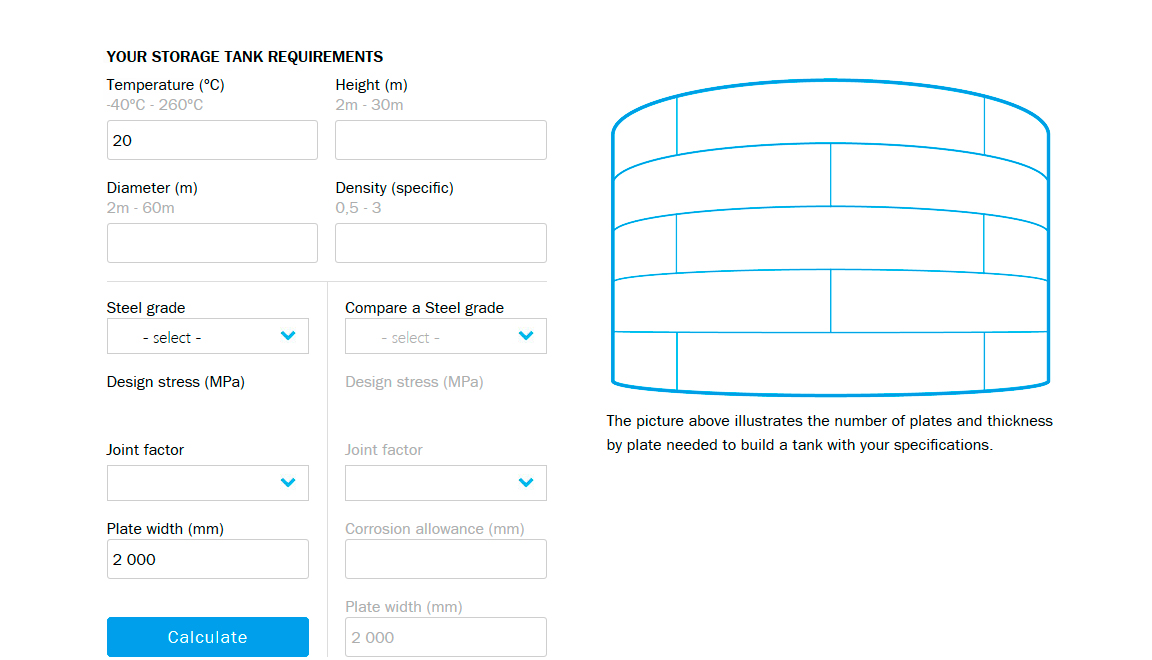Steel storage tanks – containing valuable liquids from wine to industrial solvents – play a critical role in a diverse array of industries. But not all steels are equal, and tank builders need the ability to comparison shop to find the optimal grade for their projects. Luckily, Outokumpu has developed an online calculator that lets them do just that.
It is called the ‘Storage tank shell thickness calculation tool’, with ‘shell’ referring to the walls of the structure, explains Peder Claesson, Outokumpu Product Manager for Forta. A fair degree of computation is needed to determine how strong each section of the shell needs to be and hence how much steel is needed overall. “Simply put, when you fill the tank up with some sort of liquid, you will have the internal load. The thickness of the shell is not going to be the same all over – it’s going to be thinner on the top and thicker on the bottom because that’s where you have the most pressure,” he says.
Thinner is the winner
This is where the choice of materials comes into play, since the computation of the shell thickness is determined by the steel grade’s strength and, in the case of carbon steel, its ability to resist corrosion. And here’s a spoiler: In most cases, the duplex stainless grades come out on top in terms of material savings, followed by the austenitic stainless grades. The carbon steel grades, which are less corrosion-resistant, trail in third.
“The main purpose of having this tool on the internet is to show potential customers how they can save weight and therefore money by using duplex instead of standard stainless steel. It also gives us an opportunity to show how duplex compares with carbon steel in terms of reducing wall thickness,” Claesson says.
But the tool is more than just a teaser touting stainless. Users can compare one type of duplex to another, or one type of austenitic to another, to see which best matches their needs to produce tanks with the thinnest shells. “With this tool, you can see how much thinner you can go at the bottom. The thinner it is, the easier it is to weld. If we’re talking about a tank weighing 70 tons versus a tank weight of 45 tons, the lighter tank is going to be easier to work with, to move around, lift, and so on. And of course there are the material cost savings to consider as well,” he says.
Going head-to-head
Potential customers using the tool, which can be found on Outokumpu’s website, start by entering their tank’s dimensions as well as the temperature and density of the material being stored. They are also asked to feed in the plate width and joint factor they wish to use. If carbon steel is part of the comparison, there is also a corrosion allowance field to account for extra millimeters that the stored material is expected to eat up during the tank’s lifetime. For the head-to-head comparison, users can pick one of four grades of duplex steel or four grades of austenitic steel, setting them either against each other or against a choice of four carbon steel grades.
The output they get is a simplified graphic showing the required thickness of each and every lap, or plate-width, of the tank, from top to bottom. “So it might tell you that the upper four laps are going to be 6 millimeters with duplex, and as we go down the next five are going to be 7 millimeters, and the one at the bottom should be 8 millimeters. Then it specifies how much material you would use for the two different steel grades you are comparing,” Claesson explains. “For example, it could show that you would need that 64 metric tons of your chosen duplex grade as against 105 metric tons of carbon steel, which would come to a 40% material saving.”
The final steps
The only figure the online calculator doesn’t specify is the price. Claesson notes that world market metal prices fluctuate too rapidly to lock in an accurate answer on that score. After completing the calculation, customers using the online tool simply have to click its ‘Contact Us’ button to begin a dialog with an Outokumpu representative, who will provide many more details – including prices – specific to the planned project.
Outokumpu is one of only a few companies that offer plates as wide as 2 meters (72” in the US).
“When we go out to customers we have a more advanced tool in Excel form that shows exactly how much you would buy in duplex or carbon. You can feed in what the customer is actually buying today and it tells you how much your shell would cost, including the cost of coating of the carbon steel and welding,” Claesson says. That last factor, welding, represents a significant part of the cost. Here it is important to note that Outokumpu is one of only a few companies that offer plates as wide as 2 meters (72'' in the US). Compared with the commonly used 1.5-meter plate-widths customers are familiar with, the savings can be considerable. “The cost of welding consists of material plus time, and welds are always critical. If you have to do any non-destructive testing, you want to minimize the welds,” notes Claesson. Now armed with accurate and complete data about their steel grade options, customers can next begin planning their storage tank projects, making informed choices to achieve optimal results.
